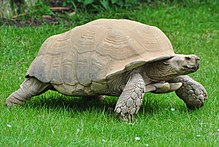African spurred tortoise
| African spurred tortoise | |
|---|---|

| |
| At Linton Zoo | |
Conservation status
| |
| Scientific classification | |
| Kingdom: | Animalia |
| Phylum: | Chordata |
| Class: | Reptilia |
| Order: | Testudines |
| Suborder: | Cryptodira |
| Superfamily: | Testudinoidea |
| Family: | Testudinidae |
| Genus: | Centrochelys |
| Species: | C. sulcata
|
| Binomial name | |
| Centrochelys sulcata (Miller, 1779)
| |
| Synonyms[2] | |
| |
The African spurred tortoise (Centrochelys sulcata), also called the sulcata tortoise, is a species of tortoise inhabiting the southern edge of the Sahara desert in Africa. It is the third-largest species of tortoise in the world, the largest species of mainland tortoise, and the only extant species in the genus Centrochelys.
Taxonomy and etymology[]
Its specific name sulcata is from the Latin word sulcus meaning "furrow" and refers to the furrows on the tortoise's scales.
Range and habitat[]

The African spurred tortoise is native to the Sahara Desert and the Sahel, a transitional ecoregion of semiarid grasslands, savannas, and thorn shrublands found in the countries of Burkina Faso, the Central African Republic, Chad, Eritrea, Ethiopia, Mali, Mauritania, Nigeria, Senegal, Saudi Arabia, Sudan, Yemen and possibly in Somalia, Algeria, Benin, and Cameroon. It is possibly extirpated from Djibouti and Togo.[1] In these arid regions, the tortoise excavates burrows in the ground to get to areas with higher moisture levels, and spends the hottest part of the day in these burrows.[3] This is known as aestivation. In the wild, they may burrow very deep; up to 15 m deep and 30 m long.[4] Plants such as grasses and succulents grow around their burrows if kept moist and in nature continue to grow for the tortoise to eat if the soil is replenished with its feces.[3] Sulcata tortoises found in the Sudanese part of their range may reach significantly greater size at maturity than those found in other regions.
Size and lifespan[]
C. sulcata is the third-largest species of tortoise in the world after the Galapagos tortoise, and Aldabra giant tortoise, and the largest of the mainland tortoises.[4] Bill Branch reported a maximum size in the wild as 83 cm and 98 kg,[4] but others state that they can reach 105 kg (231 lb).[5] They grow from hatchling size (2–3 in) very quickly, reaching 6–10 in (15–25 cm) within the first few years of their lives. They can live more than 70 years.[6]
Diet[]

Sulcata tortoises are herbivores. Primarily, their diets consist of many types of grasses and plants, high in fiber and very low in protein. Flowers and other plants including cactus pads can be consumed. Fruits such as apples are somewhat healthy for the tortoise although various vegetables such as kale and lettuce are better. [7]
Breeding[]
Copulation takes place right after the rainy season, during the months from September through November.[3] Males combat each other for breeding rights with the females and are vocal during copulation.[3]
Sixty days after mating, the female begins to roam looking for suitable nesting sites.[3] For five to fifteen days, four or five nests may be excavated before she selects the perfect location in which the eggs will be laid.[3]
Loose soil is kicked out of the depression, and the female may frequently urinate into the depression.[3] Once it reaches about two feet (60 cm) in diameter and 3–6 in (7–14 cm) deep, a further depression, measuring some eight inches (20 cm) across and in depth, will be dug out towards the back of the original depression.[3] The work of digging the nest may take up to five hours; the speed with which it is dug seems to be dependent upon the relative hardness of the ground.[3] It usually takes place when the ambient air temperature is at least 78 °F (27 °C).[3] Once the nest is dug, the female begins to lay an egg every three minutes.[3] Clutches may contain 15–30 or more eggs.[3] After the eggs are laid, the female fills in the nest, taking an hour or more to fully cover them all.[3] Incubation should be 86 to 88 °F, and will take from 90 to 120 days.
References[]
- ^ a b Petrozzi, F.; Luiselli, L.; Hema, E.M.; Diagne, T.; Segniagbeto, G.H.; Eniang, E.A.; Leuteritz, T.E.J.; Rhodin, A.G.J. (2021). "Centrochelys sulcata". IUCN Red List of Threatened Species. 2021: e.T163423A1006958. doi:10.2305/IUCN.UK.2021-1.RLTS.T163423A1006958.en. Retrieved 30 July 2021.
- ^ Fritz Uwe; Peter Havaš (2007). "Checklist of Chelonians of the World" (PDF). Vertebrate Zoology. 57 (2): 279–280. ISSN 1864-5755. Archived from the original (PDF) on 2011-05-01. Retrieved 29 May 2012.
- ^ a b c d e f g h i j k l m Kaplan, Melissa. (1996)African Spurred Tortoises. Reptile and Amphibian Magazine, September/October 1996, pp. 32–45
- ^ a b c Branch, Bill (2008). Tortoises, Terrapins & Turtles of Africa. South Africa: Struik Publishers. p. 128. ISBN 978-1-77007-463-7.
- ^ African Spurred Tortoise Archived 2015-10-26 at the Wayback Machine, Arkive
- ^ "Sulcata Tortoise Care Sheet". www.reptilesmagazine.com. Retrieved 2018-02-27.
- ^ Gurley, Russ (2002). The African Spurred Tortoise Geochelone sulcate in Captivity. ISBN 978-1-885209-25-2.
External links[]
| Wikimedia Commons has media related to African Spurred Tortoise. |
- IUCN Red List endangered species
- Testudinidae
- Turtles of Africa
- Reptiles described in 1779
- Taxa named by John Frederick Miller



